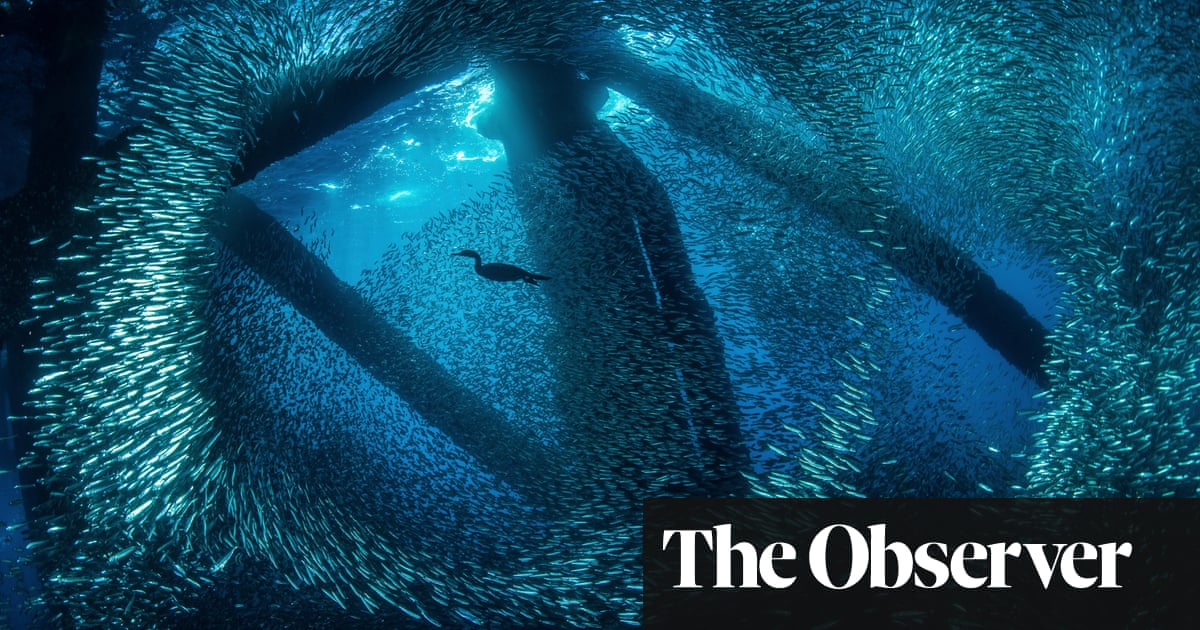
he main exhibition room at the Natural History Museum in London is cathedral-like, with Hope the blue whale suspended mid-air like a demigod. Filled with specimens collected by explorers, this remarkable place teaches us about the evolution of life on our planet.
There is a “great unlocking” happening in this building, home to one of the world’s largest natural history collections. Insects on pins and old minerals that have been sitting in mahogany display cases for hundreds of years are being re-examined, digitised and brought into the 21st century.
In the bowels of the museum – empty due to Covid-19 – scientists are working to protect the planet for the future, as well as preserving its past.
The two white cryogenic tanks in the museum’s basement can store genetic data from all 70,000 known species of animal, plant, fungi and protozoa found in the UK. If the Darwin Tree of Life project is a success, Britain will be the first country to record the genome of every one of its species.
Badgers, bats and beetles are not being stuffed into the tubs of -196C liquid nitrogen, but lentil-sized samples of their tissues are. This is all scientists need to extract DNA and sequence an entire genome. For some insects this does mean the whole organism; for larger animals it could be a drop of blood.
Each sample is put in a little plastic tube within a drawer. They rotate inside like a spice rack and, in theory, the DNA should be protected for ever in those conditions. “The amount of information you can get from one tiny insect now is incredible,” says Dr Gavin Broad, principal curator in charge of insects at the museum.
Victorian collectors exploring far-flung lands have been replaced by amateurs recording wildlife closer to home. The project relies on British wildlife enthusiasts contributing specimens by catching them in nets, wading through rivers, or using light traps. A few thousand species (mainly insects and spiders) have already been collected and scientists aim to have them all in the next 10 to 12 years.
“We’ve got this amazing network of amateur entomologists out there, so we’re getting people sending us specimens in the post. The post room must be filled with packages saying ‘live insects’,” says Broad.
The museum already has a comprehensive checklist of species to find. Specimens are sent to the museum for barcoding, and to the Wellcome Sanger Institute near Cambridge for full genomic sequencing. It follows on from the Human Genome Project, widely considered one of the greatest feats of science, described as biology’s answer to the Apollo space programme.
“Who knows what sort of advances will come out of this,” says Broad, who describes it as a “big infrastructure project”. The DNA will show how organisms have adapted to their environment and how they are responding to change. The project will open up the rest of the 80 million specimens in the museum to DNA sequencing. “When you’ve got a fresh genome you can go back to the old specimens … You can get those tiny fragments of DNA out of hundred-year-old specimens and match them to your genome scaffold,” says Broad.
The results will be made publicly available online and will form part of the Earth BioGenome Project, which aims to sequence all life on the planet.
Upstairs, Helen Hardy, digital collections programme manager, is getting to grips with some of the older specimens – the museum’s chalcid wasps, which are just a few millimetres long. They look like bits of dirt to the naked eye and some have been sitting in an old-fashioned display case for more than 100 years. It is hard to get excited about them until you see them magnified, revealing their bright colours and strange-looking wings.
Digitising involves taking high-definition images of the species and then information about where it was found, when, and by whom. A barcode identifies each one and the process should take less than a minute – provided the label is clear. “The Victorians had really nice handwriting – people either side not so much,” says Hardy, who has become experienced at deciphering illegible scrawl and has “tricky transcriptions” meetings on Fridays.
There are 7,000 species of wasp in the UK and information on these small, seemingly unremarkable organisms is proving vital to protecting biodiversity. “Things we overlook are really important to our food supply – it’s a bit like burning a library without checking what books are in it first,” says Hardy. Less than 6% of the museum’s collection is online. Restricted movement due to Covid-19 has highlighted the importance of digital surrogates of collected objects, she says.
The data Hardy and her team are releasing feeds into aggregates, such as the Global Biodiversity Information Facility. There were 25bn records downloaded between February 2015 and February 2021, and none before that. Since 2016, 850 papers have relied on at least one of those digital specimens, including the UK State of Nature report and Intergovernmental Science-Policy Platform on Biodiversity and Ecosystem Services.
“With things like Cop26 this year, there are loads of decisions being made about investment and important policy on the environment and conservation,” says Hardy. “If they’re not using collections data then they’re based on, at best, a few decades of data. If you really want to know the state of things before humans started changing land use and making things different, collections are really the only baseline for that.”
The museum is part of the Europe-wide DiSSCo project (Distributed System of Scientific Collections), which involves 115 museums digitising their collections so they are available online for researchers across the world.
Back in the main exhibition room, the mineral collection is set out as it was in Victorian times, with ornately decorated stone pillars, church-like windows and wooden display cases built into the fabric of the building. Less than 5% of the 180,000 species of minerals in the collection are on display.
“Finding new things in the collection is definitely my area,” says Mike Rumsey, principal curator of minerals at the museum. “I really love to look at the old materials and see what people have missed in the past because technologies are so much better. The reason there’s work for me is because when loads of things came in, in 1880, they hadn’t been analysed to the same level that we can now,” he says.
Last year, Rumsey helped discover a new mineral that had been sitting in the collection for 220 years after being excavated from a Cornish mine.
A display case contains a family of minerals called spodumene in various shades of pink, green and grey. They have one thing in common – they all contain lithium, a metal that will be key to the transition to net zero by 2050. An electric car, for example, requires on average 10 to 15kg of lithium to make it, extracted from about 60 tonnes of rock.
New lithium-bearing minerals can be identified by their chemical properties and crystal structure, which means how the atoms are arranged three-dimensionally. There are 6,000 known species of minerals globally, with about 100 new species discovered each year.
Most of the world’s lithium comes from South America or Australia, and there is no commercial production in Europe. It was announced that large quantities of lithium had been discovered near the village of Gwennap in Cornwall last September. The company that found it, Cornish Lithium, claimed it could be enough to meet all the UK’s demands.
“We do know it’s technically feasible to recover lithium from rocks in Britain, says Prof Richard Herrington, head of the earth sciences department. “So that’s pretty interesting because, if you’re looking at having a secure supply chain and something that you can source locally, mining things closer to home might be a good thing.”
The museum is working with Cornish Lithium as part of its Li4UK project, which hopes to find supplies of lithium-bearing minerals in UK rocks and geothermal waters. Unlocking mineral data from the collection will provide information for researchers about where they should look for metals critical to the transition to the green economy. There might be lithium-bearing minerals still to be discovered in the collection.
The museum’s collection is outgrowing the confines of its Victorian structure. Laboratories doing cutting-edge research have wrapped themselves around the old Victorian building like parasites, feeding off its vast resources.
But this is about to change. Over the next five years, the government has pledged £180m to the museum to create a new research centre in Harwell, south of Oxford, which will house 40% of the museum’s collections, as well as laboratories and facilities for digitisation.
Although Covid-19 has stopped a lot of work, it has highlighted the importance of researchers all over the world having online access to collections.
“It’s all part of this great unlocking, and the timing is perfect in a way because while we’re locked down we’re doing all the planning for this Harwell move,” says Herrington. “It will be a physical move in the next five years, and we would hopefully escalate the digitisation process to increase the collection of new and useful data about individual specimens.”
The Natural History Museum will reopen to visitors from Monday, 17 May












